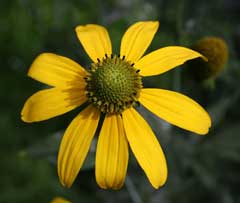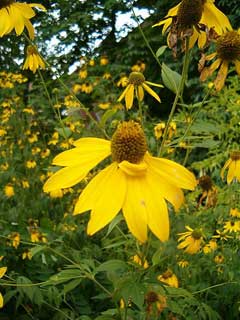 |
|
http://commons.wikimedia.org/wiki/User:Pleple2000 |
 |
| http://commons.wikimedia.org/wiki/User:BotBln |
Translate this page:
Summary
Bloom Color: Yellow. Main Bloom Time: Early fall, Late summer, Mid summer. Form: Upright or erect.
Physical Characteristics

 Rudbeckia laciniata is a PERENNIAL growing to 2.4 m (7ft) by 1 m (3ft 3in) at a medium rate.
Rudbeckia laciniata is a PERENNIAL growing to 2.4 m (7ft) by 1 m (3ft 3in) at a medium rate.
See above for USDA hardiness. It is hardy to UK zone 3. It is in flower from July to October, and the seeds ripen from August to October. The species is hermaphrodite (has both male and female organs) and is pollinated by Bees, hoverflies.
Suitable for: light (sandy), medium (loamy) and heavy (clay) soils. Suitable pH: mildly acid, neutral and basic (mildly alkaline) soils. It can grow in semi-shade (light woodland) or no shade. It prefers moist soil. The plant can tolerates strong winds but not maritime exposure.
UK Hardiness Map
US Hardiness Map
Synonyms
Plant Habitats
Woodland Garden Sunny Edge; Shady Edge; Meadow;
Edible Uses
Edible Parts: Stem
Edible Uses:
Edible young stems[105, 155, 161]. Cooked and eaten in the spring for 'good health'[222, 257]. The young stems can be eaten like celery[257]. The stems can also be dried for later use[257]. Some caution is advised, see the notes above on toxicity.
References More on Edible Uses
Medicinal Uses
Plants For A Future can not take any responsibility for any adverse effects from the use of plants. Always seek advice from a professional before using a plant medicinally.
Carminative Poultice
A tea made from the root (mixed with Caulophyllum thalictroides) is used in the treatment of indigestion[222, 257]. A poultice of the flowers (mixed with Agastache anisatum and Solidago sp.) is applied to burns[222, 257].
References More on Medicinal Uses
The Bookshop: Edible Plant Books
Our Latest books on Perennial Plants For Food Forests and Permaculture Gardens in paperback or digital formats.

Edible Tropical Plants
Food Forest Plants for Hotter Conditions: 250+ Plants For Tropical Food Forests & Permaculture Gardens.
More

Edible Temperate Plants
Plants for Your Food Forest: 500 Plants for Temperate Food Forests & Permaculture Gardens.
More

More Books
PFAF have eight books available in paperback and digital formats. Browse the shop for more information.
Shop Now
Other Uses
Dye
A green dye is obtained from the flowers[168].
Special Uses
References More on Other Uses
Cultivation details
Landscape Uses:Container, Massing. Succeeds in an ordinary medium soil in sun or shade[111]. Requires a moist soil[1]. Prefers a well-drained soil[188]. Tolerates considerable wind exposure without support[K]. Plants can be grown in quite coarse grass, which can be cut annually in the autumn[233]. They grow particularly well in long hot late summers[200]. Dormant plants are hardy to about -25°c[187]. Some named forms have been selected for their ornamental value[187]. Members of this genus are rarely if ever troubled by browsing deer[233]. Plants can be invasive[200]. Special Features:Attracts birds, North American native, All or parts of this plant are poisonous, Attracts butterflies, Suitable for cut flowers.
References Carbon Farming Information and Carbon Sequestration Information
Temperature Converter
Type a value in the Celsius field to convert the value to Fahrenheit:
Fahrenheit:
The PFAF Bookshop
Plants For A Future have a number of books available in paperback and digital form. Book titles include Edible Plants, Edible Perennials, Edible Trees,Edible Shrubs, Woodland Gardening, and Temperate Food Forest Plants. Our new book is Food Forest Plants For Hotter Conditions (Tropical and Sub-Tropical).
Shop Now
Plant Propagation
Seed - sow April in a greenhouse. Only just cover the seed. Germination should take place within 2 weeks, prick out the seedlings into individual pots when they are large enough to handle and plant them out in the summer[K]. The seed can also be sown in situ[111]. Division in spring or autumn[111]. Very easy, larger divisions can be planted out direct into their permanent positions. We have found it best to pot up the smaller divisions and grow them on in a lightly shaded position in a cold frame, planting them out once they are well established in the summer.
Other Names
If available other names are mentioned here
Native Range
NORTHERN AMERICA: Canada (Québec (south), Nova Scotia, Ontario (south), Prince Edward Island, New Brunswick, Manitoba (south)), United States (Connecticut, Indiana, Maine (south), Massachusetts, Michigan, New Hampshire, New Jersey, New York, Ohio, Pennsylvania, Vermont, West Virginia, Illinois, Iowa, Kansas, Minnesota, Missouri, Nebraska, North Dakota, Oklahoma, South Dakota, Wisconsin, Colorado, Montana, Wyoming, Alabama, Arkansas, Delaware, Florida, Georgia, Kentucky, Louisiana, Maryland, Mississippi, North Carolina, South Carolina, Tennessee, Virginia, New Mexico, Texas, Arizona (east), Utah)
Weed Potential
Right plant wrong place. We are currently updating this section.
Please note that a plant may be invasive in one area but may not in your area so it's worth checking.
Conservation Status
IUCN Red List of Threatened Plants Status :

Growth: S = slow M = medium F = fast. Soil: L = light (sandy) M = medium H = heavy (clay). pH: A = acid N = neutral B = basic (alkaline). Shade: F = full shade S = semi-shade N = no shade. Moisture: D = dry M = Moist We = wet Wa = water.
Now available:
Food Forest Plants for Mediterranean Conditions
350+ Perennial Plants For Mediterranean and Drier Food Forests and Permaculture Gardens.
[Paperback and eBook]
This is the third in Plants For A Future's series of plant guides for food forests tailored to
specific climate zones. Following volumes on temperate and tropical ecosystems, this book focuses
on species suited to Mediterranean conditions—regions with hot, dry summers and cool, wet winters,
often facing the added challenge of climate change.
Read More
Expert comment
Author
L.
Botanical References
60200
Links / References
For a list of references used on this page please go here
Readers comment
© 2010, Plants For A Future. Plants For A Future is a charitable company limited by guarantee, registered in England and Wales. Charity No. 1057719, Company No. 3204567.